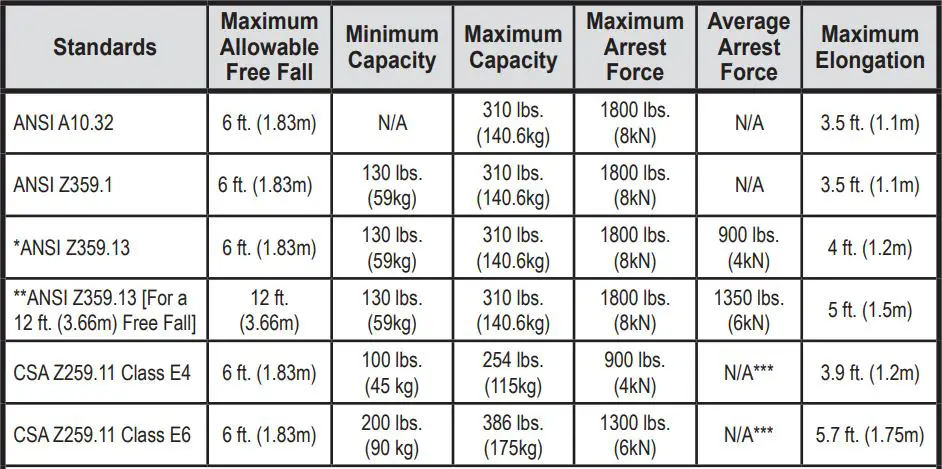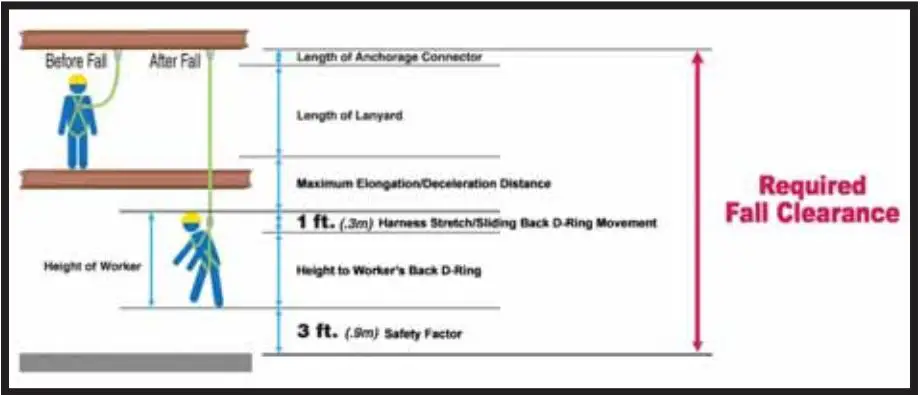Miller 913BDO/6FTBL BackBitter Tie-Back Lanyard Instruction Manual

Understanding Shock Absorber Differences
Miller Fall Protection is dedicated to product development and user needs, and therefore offers different shock absorber styles as well as products that med different performance specifications for personal shock absorbers and shock-absorbing lanyards. It is imperative to know and understand these differences to ensure safety on the jobsite.
Shock Absorber Styles
There are two primary Miller shock absorber styles for lanyards: built-in and pack.
- The built-in shock absorber is a specially-woven inner core within a tubular lanyard that smoothly expands to reduce fall arrest forces.
- The pack shock absorber is a readily visible component of the lanyard. Inside the pack is a specially-woven inner core that smoothly expands to reduce fall arrest forces as well as a heavy-duty back- Built-In Shock Absorber Pack Shock Absorber up safety strap.




*The ANSI Z359.13-2009 standard increased the steel test weight used by manufacturers to test personal shock absorbers and shock-absorbing lanyards from 220 to 282 lbs. (100-128kg). Because of the heavier test weight requirement, the ANSI standard now allows for greater shock absorber elongation. **The ANSI Z359.13 standard addresses design and performance requirements for double-pack shock absorbers, such as the Miller MAX shock absorbers and Titan X2 shock absorbers, which may be used for a 12-foot (3.66m) free fall situation. Alternative means of fall protection should always be investigated prior to using systems that allow for free falls greater than 6 ft. (1.83m). [Note: Miller MAX and Titan X2 shock absorbers may also be used for workers weighing between 311 lbs. (141kg) and 400 lbs. (181.4kg), but free fall must be limited to 6 ft. (1.83m) or less in this application.] ***Average arrest force of Miller E4 shock absorbers: 874 lbs. (3.8kN); Average arrest force of Miller E6 shock absorbers: 1250 lbs. (5.6kN)
MAXIMUM CAPACITY WARNING: If the system is used by an employee having a combined tool and body weight between 310 lbs. (140.6 kg) and 400 lbs. (181.4 kg), then the employer must appropriately modify the criteria and protocols to provide proper protection for such heavier weights, or the system will not be deemed to be in compliance with the requirements of OSHA 1926.502(d)(16).
ANSI Z359.13 WARNING: If the labels and/or instructions of other Miller Fall Protection products and systems indicate that they are only to be used with personal fall arrest equipment that limits maximum fall arrest forces to 900 lbs. (4kN) or less, do not use with new ANSI Z359.13-2009 compliant product until otherwise authorized to do so by Miller Fall Protection. Contact Miller Technical Services for further information.
If there are any questions regarding the differences between Miller shock absorbers and shock absorbing products and their specified performance characteristics, Please contact Miller Technical Services before using the equipment.
Calculating Fall Clearance Distance
It is essential to understand how to calculate potential fall clearance for each work application to avoid contact with a lower level. Use the following calculation to determine Required fall Clearance.
Shock-Absorbing Lanyard Fall Clearance Calculation[Calculation taken from connection point of lanyard to anchorage or anchorage connector]Length of Lanyard+ Maximum Elongation/Deceleration Distance+ 1 ft. (.3m) Harness Stretch/Sliding Back D-Ring Movement+Height to Worker’s Back D-Ring+ 3 ft. (.9m) Safety Factor =Required Fall Clearance
NOTE: A fall clearance calculation made from the anchor point must take into consideration the length of the anchorage connector being used.
 Sample CalculationThe following illustration demonstrates a sample calculation using a shock-absorbing lanyard. When actually calculating fall clearance distance, the authorized person/user must consider all variables, including but not limited to the height of the worker, the length of the lanyard, the specified maximum elongation of the lanyard, and the anchorage connector used, and then make necessary adjustments to the calculation.
Sample CalculationThe following illustration demonstrates a sample calculation using a shock-absorbing lanyard. When actually calculating fall clearance distance, the authorized person/user must consider all variables, including but not limited to the height of the worker, the length of the lanyard, the specified maximum elongation of the lanyard, and the anchorage connector used, and then make necessary adjustments to the calculation.
 If there is any question about calculating fall clearance distance, please contact Miller Fall Protection Technical Services Department at 1-800-5242
If there is any question about calculating fall clearance distance, please contact Miller Fall Protection Technical Services Department at 1-800-5242

Toll Free: 800.873.5242Fax: 800389234078
Download this manual at: www.millerfallprotection.com
Honeywell Safety ProductsP.O. Box 271, 1345 15th StreetFranklin, PA 16323 USA
[xyz-ips snippet=”download-snippet”]

